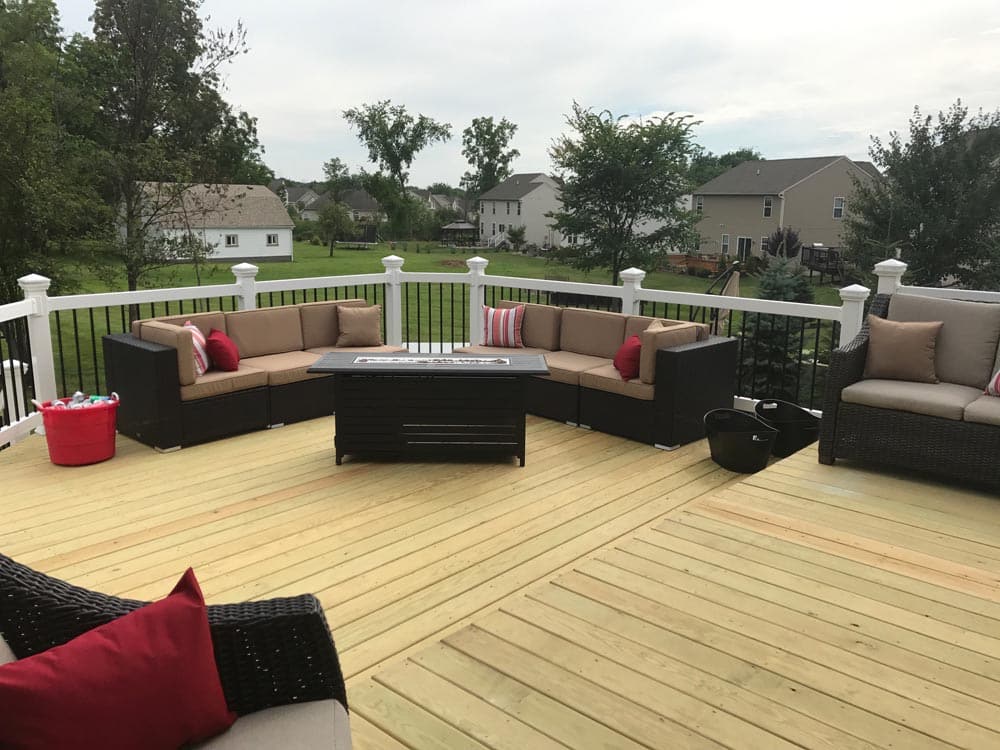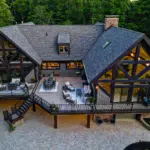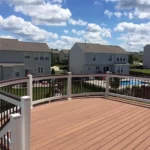So, you want to build a custom deck. But which material should you choose? Understanding the wood vs composite decking differences can help you make an informed decision for your outdoor living space.

What is Wood Decking?
Wood decking comprises natural lumber planks used to create outdoor deck surfaces. This material provides an authentic, traditional appearance, enhancing the aesthetic appeal of outdoor spaces.
Common Wood Species Used
- Cedar: Known for its resistance to decay and attractive grain.
- Redwood: Valued for its durability and rich, natural color.
- Pressure-treated Pine: Treated with chemicals to resist rot and insect damage.
Pros of Wood Decking
- Natural Beauty and Warmth: Delivers a natural, inviting look that blends seamlessly with the environment.
- Traditional and Classic Look: Ideal for creating a timeless, classic design that enhances home value.
- Customizable Color: Can be stained or sealed to achieve a wide range of colors and finishes, allowing for personalized design.
Cons of Wood Decking
- Requires Regular Maintenance: Regular sanding, staining, and sealing are needed to maintain appearance and structural integrity.
- Prone to Moisture Damage: Susceptible to warping, splintering, and rot when exposed to moisture.
- Susceptible to Insect Damage: Vulnerable to termites and other wood-boring insects.
- Shorter Lifespan: Typically has a shorter lifespan compared to composite decking, leading to more frequent replacement.
What is Composite Decking?
Composite decking is made from a blend of wood fibers and plastics, designed to mimic the appearance of wood while offering enhanced durability and low maintenance requirements.
Manufacturing Process and Common Brands
The manufacturing process involves combining wood fibers with plastic materials, typically recycled, and forming them into planks through extrusion. This process creates boards with consistent quality and appearance. Notable brands include Trex and MoistureShield.
Pros of Composite Decking
- Low Maintenance: Requires only periodic cleaning with soap and water, eliminating the need for sanding, staining, or sealing.
- Highly Durable: Offers long-lasting performance and is resistant to fading, staining, and scratching.
- Resistant to Moisture, Insects, Warping, and Splintering: Superior resistance to environmental damage compared to wood.
- Eco-Friendly: Often made from recycled materials, reducing environmental impact.
- Variety of Colors and Realistic Wood-Look Designs: These are available in a wide range of colors and textures, some closely mimicking the appearance of natural wood.
Cons of Composite Decking
- Higher Upfront Cost: The initial investment is higher than traditional wood decking.
- Doesn’t Have the Exact Same Natural Look as Real Wood: Despite advancements, it still lacks the exact authenticity of natural wood.
- Can’t Be Refinished: Offers a single, permanent color that cannot be changed once installed.
The Key Differences: Wood vs Composite Decking
Here’s a side-by-side view of the composite vs wood decking differences:
| Key Differences | Wood Decking | Composite Decking |
|---|---|---|
| Appearance | Offers a classic, natural look that can be stained or sealed to various colors. | Mimics the look of wood with a wide variety of colors and grain patterns, though it does not exactly replicate the natural appearance of real wood. |
| Durability | Lifespan ranges from 10-30 years with proper maintenance, susceptible to weathering, rot, and insect damage. | Extremely durable with a lifespan of 25-50 years, resistant to rot, warping, and insect damage. |
| Maintenance | Requires frequent sanding, staining, and sealing to maintain its appearance and structural integrity. | Very low maintenance, requiring only periodic cleaning with soap and water. |
| Cost | Cheaper initially but incurs ongoing maintenance costs, which can add up over the deck’s lifespan. | Higher upfront cost but lower maintenance expenses over time. |
| Environmental Impact | Renewable resource, but certain types require chemical treatments that can be harmful to the environment. | Often made from recycled materials, making it an eco-friendly option. |
| Moisture Resistance | Prone to moisture damage, which can lead to decay, warping, and splintering. | Highly resistant to moisture and rot, ideal for humid or wet environments. |
| Workability | Easily cut and drilled with regular woodworking tools, offering more flexibility in design. | Requires specialized tools due to its density, which can complicate installation. |
| Heat Resistance | Stays cooler under the sun but is prone to cracking and splintering under extreme temperatures. | Can become hotter than wood in direct sunlight, which may affect comfort. |
How MoistureShield Decking Stacks Up Against Wood
At Hen-House Decks, MoistureShield composite decking products are among our favorites for custom deck projects, more so than wood. What is the best composite decking? MoistureShield is very good, and Trex is a good alternative, too. Here are some of the reasons why we like MoistureShield when compared to wood:
- Durability and Lifespan: MoistureShield composite decking offers superior durability compared to traditional wood decking. It is engineered to resist moisture, rot, splintering, warping, and insect damage. MoistureShield boasts a 30-50 years lifespan, significantly longer than the typical 10-30 years for wood decking.
- Maintenance: MoistureShield decking requires minimal maintenance. It only needs occasional cleaning with soap and water to maintain its appearance. This low-maintenance requirement translates to less time and money spent on upkeep, allowing homeowners to enjoy their deck without the hassle of ongoing maintenance tasks.
- Environmental Impact: MoistureShield decking is an eco-friendly option, often made from recycled materials, including reclaimed wood fibers and plastics.
- Moisture Resistance: MoistureShield excels in moisture resistance, a critical factor in decking durability. This is why we love it for pool decks. Its composite material is designed to withstand high humidity, heavy rainfall, and direct water contact without suffering from rot or decay.
- Workability: Wood is easier to cut and shape using standard woodworking tools. MoistureShield, being a denser composite material, requires specialized tools for cutting and drilling. However, its consistent quality and lack of imperfections can make installation more straightforward and predictable.
- Heat Resistance: Homeowners concerned about surface temperature can explore MoistureShield’s CoolDeck technology, which reduces heat absorption, making the deck surface cooler to walk on.
- Cost and Value: While MoistureShield has a higher upfront cost than traditional wood decking, its long-term value is greater due to its extended lifespan and minimal maintenance requirements. The reduced need for repairs, treatments, and replacements makes it a cost-effective choice. Wood decking may be less expensive initially, but the cumulative costs of regular maintenance and shorter lifespan can result in higher overall expenses.
Wood vs Composite Decking: What Will it Be for Your Deck?
Ready to elevate your home’s outdoor environment? Whether you prefer the classic beauty of wood, the low-maintenance durability of composite, or the exceptional benefits of MoistureShield decking, our creative team at Hen-House Decks can help. Explore our modern multi-level deck designs to reimagine your space.
Contact us today to design a personalized decking solution that enhances your lifestyle and maximizes outdoor enjoyment.









